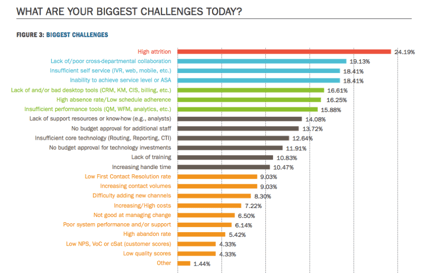
Each New Year brings its own set of unique opportunities to the contact center space, both from a technological standpoint as well as an operational one. And as businesses continue to adopt the latest solutions and best practices to support their employees, customers, and organizations as a whole, many continue to run into challenges piecing everything together and making good use of it all. But what are some of the challenges contact centers are anticipating in the coming months? And how can businesses more effectively manage what they have and mitigate the risk of a potential issue? Let's check out the findings of Contact Center Pipeline’s recent survey, “Contact Center Challenges & Priorities”, revealing some of the biggest challenges for organizations today—and how to alleviate them in 2016.
1) High attrition [24.19%]: Employee attrition has been a long-standing issue within the contact center space for years (especially for larger call centers of over 500 seats), and continues to be a major pain point today despite recent advancements in technology and employee work environment. In fact, the average call center sees an annual turnover of 33%, incurring turnover costs of 25-30% of a full salary and benefits per employee. But there are a few things businesses can do to enhance agent work lives and reduce agent attrition rates in 2016:
- Hire a top-notch team to recruit the right individuals
- Create in-depth training programs to ensure employees are well-versed on the company and its various offerings, and provide recordings of real-life scenarios they can study and learn from
- Continuously coach employees throughout their time at your company using advanced QA tools, such as whisper and barge-in, robust reporting engines, and WFO solutions such as Envision Inc.’s “Click2Coach”
- Streamline the agent desktop, and provide employees with the tools they need to succeed, such as dynamic scripting engines, easy-to-use dialers, CTI, click-to-call, automated scheduling, and immediate access to client information
- Make the work environment fun through gamification strategies, competition, prizes, and continual praise for high performance
2) Lack of/poor cross-departmental collaboration [19.13%]: Many contact centers continue to suffer from the effects of poor cross-departmental collaboration, which can greatly inhibit agents’ ability to deliver on customer needs and expectations as it relates to both sales and customer service. In fact, 60% of low first call resolutions are caused by an agent’s inability to quickly access systems data. And 26% of an agent’s time is spent looking for relevant data in various systems during each customer contact. But this issue can largely be resolved by integrating disparate database management solutions used across an organization, from accounting/billing, to marketing automation, to CRM/customer service management platforms, to contact center software—giving every employee a complete view of every customer at any given time and touch point.

3) Insufficient self-service (IVR, web, mobile, etc.) [18.41%]: Self-service is quickly becoming the most popular and sought after customer service touch point available. In fact by 2017, Gartner predicts that two-thirds of customer service interactions will not require the support of a human intermediary. And web self-service is now the most commonly used communication touch point—the first and only channel to exceed phone in history. But as it stands, 40% of consumers still call a contact center after having looked for answers to their questions via self-service, indicating that there is significant room for improvement.
When implementing self-service options via an IVR menu, contact centers should follow a few simple best practices, explained in more detail here:
- Ensure data is consistent, accurate, and relevant, and properly linked to any database management platform in use
- Avoid lengthy and confusing IVR menus
- Use customer data for proactive support
- Make it easy to gain live-assistance if desired
When implementing self-service options via an online knowledge base, contact centers should follow a few simple best practices, explained in more detail here:
- Understand what customers are searching for, and cater the knowledge base accordingly
- Understand why customers are calling to further tune the knowledge base and add any missing components
- Be proactive, and answer questions you think your customers could have down the road
- Continue improving other channels, as the knowledge base cannot solve all needs
4) Inability to achieve service level or ASA [18.41%]: The inability to achieve a predetermined service levels or Average Speed of Answer (ASA) is one of the greatest challenges faced by inbound and blended contact centers. And as customer expectations continue to rise, this problem is only expected to increase unless further measures are taken by those organizations that are struggling. The first and perhaps most important component of this is for contact centers to ensure they are utilizing a flexible telephony solution, enabling them to quickly scale to meet changes in call volume and customer demand—something only the cloud can truly provide. Contact centers should also utilize WFM solutions to help manage agent scheduling, ensuring they have the resources they need to meet desired ASA and service levels. In the event service levels aren’t being met, transparency is key—customers should be provided updates on their wait time or position in queue, and call-back options to alleviate frustration.




